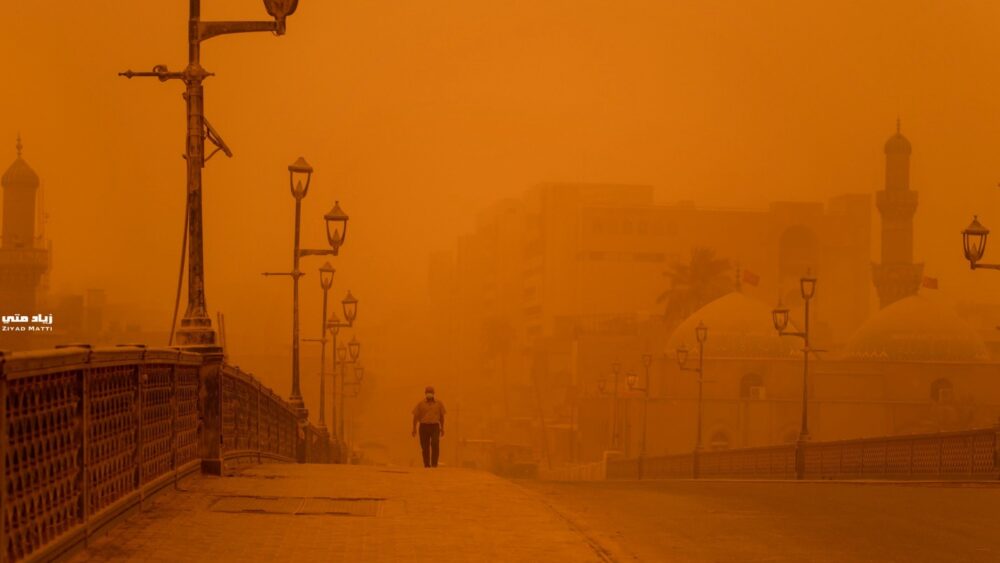In his analysis of recent air quality issues in Baghdad, Harry Istepanian highlights the alarming rise in sulfur dioxide (SO₂) emissions resulting from the burning of high-sulfur fuel oil and crude oil in the region’s industrial facilities. The Ministry of Environment has linked the sulfur-like odor troubling residents to the Doura neighborhood’s polluting refinery and power plants, exacerbated by over 250 nearby factories. With air pollution contributing to fine particulate matter (PM2.5) formation, he underscores the urgent need for effective emissions controls and public health measures to safeguard the population’s well-being.
In recent days, residents of Baghdad have been grappling with a pervasive sulfur-like odor that has become increasingly difficult to ignore. This unsettling phenomenon has prompted widespread concern about air quality and public health across the capital. In a press conference alongside the Parliamentary Health and Environment Committee, the Ministry of Environment attributed the smell to the burning of high-sulfur fuel oil in various industrial facilities located around the city. Officials warned that the high sulfur content in the burned oil is responsible for the release of toxic gases into the atmosphere, posing serious health risks to the population.
Major Sources of Pollution
One of the primary sources of sulfur pollution is the Doura neighborhood, which is home to one of Iraq’s oldest oil refineries and a fleet of oil-fired power plants built in the 60s and 70s. The Doura Refinery is notorious for its outdated technology and lack of effective controls for sulfur dioxide (SO₂) emissions. This makes it a significant contributor to the air pollution that plagues the area. High concentrations of sulfur released during the combustion of crude oil or its derivatives not only contribute to deteriorating air quality but also lead to serious respiratory issues among the local populace.
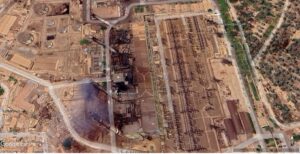
Daura Power Station (Courtesy of Google Earth)
The Ministry of Environment has directed blame toward the Ministries of Electricity and Oil, which oversee the operations of the Doura Refinery, the Doura Power Plant, and the Quds Power Station located in northern Baghdad. Additionally, over 250 privately owned factories—including asphalt plants, brick factories, and metal smelting facilities—are reportedly contributing to the city’s air pollution crisis. The situation is exacerbated by the burning of solid waste in areas like Nahrawan and Rashid Camp, further complicating efforts to mitigate the problem.
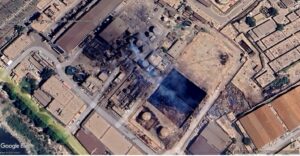
Baghdad South Power Station (Courtesy of Google Earth)
Health Risks from Sulfur Pollution
The health implications of elevated SO₂ levels are alarming and cannot be overstated. Short-term exposure to these elevated levels can lead to a range of health issues, including breathing difficulties, eye irritation, and chest tightness, particularly for vulnerable populations such as children, the elderly, and those with pre-existing respiratory conditions. The cumulative impact of these pollutants creates an immediate health crisis for those living near industrial zones.
The long-term health risks associated with chronic exposure to sulfur dioxide are even graver. Continuous exposure can lead to permanent lung damage and increase the likelihood of developing chronic respiratory diseases such as Chronic Obstructive Pulmonary Disease (COPD). Affected individuals may experience reduced lung function, exacerbating pre-existing conditions and significantly lowering their quality of life. Additionally, sulfur compounds can lead to increased hospital admissions and even premature mortality, placing a strain on the healthcare system.
The Scale of Emissions
In 2023 alone, the Ministry of Electricity reported burning around 68 million barrels of sour crude oil, alongside 25 million barrels of high-sulfur fuel oil (HSFO) and an additional 15 million barrels of mixed crude oil and HSFO to meet the country’s high electricity demands. A study on Iraq’s crude oil published in 2022 reported high sulfur content in the samples of crude oil as high as 4.0055 wt%. At the Daura Refinery, the sulfur concentration was recorded at 3.18 wt%. Such extensive burning of liquid fuels is estimated to have released over 1.2 million metric tons of sulfur dioxide into the atmosphere. Alarmingly. However, the majority of SO₂ emissions are believed to stem from burning natural gas for electricity generation. The Ministry of Electricity utilized nearly 20 billion cubic meters of both imported and domestically produced gas to generate electricity in 2023, which likely contributed an astounding 36 million tons of sulfur dioxide emissions.
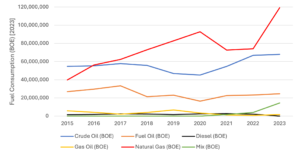
Iraq Fuel Consumption for electricity generation (Source: Ministry of Electricity, 2023)
The consequences of sulfur pollution extend beyond SO₂; hydrogen sulfide (H₂S), which is emitted in greater quantities when sulfur content rises, poses further risks to public health and the environment. Exposure to hydrogen sulfide can cause symptoms ranging from irritation of the eyes and throat to severe respiratory issues. The processing of high-sulfur crude oil in Iraq’s refineries exacerbates these health hazards, leading to increased emissions of sulfur dioxide and hydrogen sulfide. This scenario is particularly troubling in light of Iraq’s commitment to reducing greenhouse gas emissions by 1% annually by 2030 compared to business-as-usual scenarios, contingent on international support.
Impact on Air Quality and Public Health
SO₂ plays a significant role in the formation of fine particulate matter (PM2.5), a hazardous airborne pollutant notorious for penetrating deep into the lungs and bloodstream. Public health agencies warn that exposure to PM2.5 is associated with increased hospital admissions, premature mortality, and a decrease in overall life expectancy. The fine particles formed through chemical reactions from SO₂ emissions can exacerbate respiratory conditions such as asthma and bronchitis, while also increasing the risk of cardiovascular diseases. For individuals with pre-existing health conditions, the risks are magnified, often leading to severe health crises.
Additionally, these emissions contribute to the formation of acid rain, which further deteriorates air quality and indirectly impacts human health through environmental degradation. Acid rain can damage crops, and freshwater sources, creating a cascading effect on public health and the ecosystem. The economic ramifications are significant as well, with potential impacts on agriculture, tourism, and overall quality of life in affected areas.
Data from the air quality monitor (AQM) at the U.S. Embassy in Baghdad, accessed on October 14, 2024, revealed alarming PM2.5 concentrations reaching as high as 237 µg/m³. This level raises a health warning, indicating emergency conditions that could affect the entire population. Health experts have warned that the high concentration of PM2.5 can lead to acute respiratory illnesses and exacerbate chronic health conditions, placing vulnerable groups at particular risk.
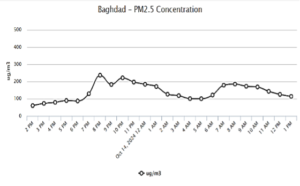
Baghdad PM2.5 Concentration on October 14, 2024 (Source: US Embassy, Baghdad)
Seasonal Variability in Air Quality
A 2019 study published in the Journal of Environmental Informatics Letters highlighted significant seasonal variability in pollutant concentrations, noting that winter months typically show higher levels of pollutants compared to summer. This increase in winter pollutants is largely attributed to stable atmospheric conditions and reduced wind speeds, which limit the dilution and dispersion of pollutants. In contrast, summer months tend to feature higher wind speeds and greater atmospheric instability, leading to lower concentrations of pollutants. The absence of terrain features of Baghdad also allows for unobstructed transport paths, facilitating straight-line trajectories of pollutant plumes throughout the area. This seasonal variability complicates the public health landscape of Baghdad, as residents may not be aware of the increased risks during the winter months.
Regulatory Efforts and International Standards
As global concern over air pollution intensifies, regulatory bodies such as the International Maritime Organization (IMO) have begun implementing sulfur caps to curb SO₂ emissions in 2020. Recent initiatives by the IMO aim to limit the sulfur content in fuel oil, potentially reducing global SO₂ emissions by up to 80%. This move reflects an urgent need to safeguard public health and the environment in light of the overwhelming evidence linking sulfur emissions to adverse health outcomes.
In Iraq, however, regulatory frameworks and enforcement mechanisms have struggled to keep pace with the rapid industrialization and energy demands of the nation. The lack of stringent regulations and effective monitoring systems has allowed industries to operate with little regard for environmental and health impacts. The need for comprehensive regulatory frameworks that prioritize air quality and public health is critical in addressing the pollution crisis.
Toward a Breathable Future
The situation in Baghdad serves as a stark reminder of the pressing need for emissions controls and public health measures to protect millions of residents affected by high levels of sulfur pollution. As government officials grapple with the complexities of air quality management, the urgency to implement effective solutions has never been greater. With a growing population and increasing industrial activities, the necessity for strategic environmental policies to mitigate the risks associated with air pollution remains critical.
Residents are left wondering what steps will be taken by the government to alleviate their suffering from the noxious sulfur odor and the health implications that accompany it. The interplay between industrial activity and public health underscores the need for an urgent and coordinated response to combat the air pollution crisis plaguing Baghdad, ensuring a healthier future for its citizens.
As Baghdad continues to contend with these environmental challenges, public health campaigns, stricter regulations on emissions, and investment in cleaner technologies are essential steps that must be taken to mitigate the negative health impacts of air pollution. Increased public awareness and community engagement will also play a crucial role in driving demand for cleaner air and holding authorities accountable for improving environmental standards.
Harry Istepanian is a PMP certified, independent Chartered Engineer (CEng.) with more than 30 years of experience in large-scale power and water utility and IWPP projects in developing countries, including SE Asia and MENA in addition to New Zealand and Australia.
![Iraq Climate Change Center [IC3+]](https://iraqclimatechange.org/wp-content/uploads/2024/06/logo2.png)
